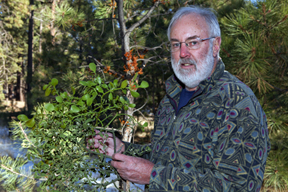Northern Arizona University researchers say there’s nothing romantic about too much mistletoe.
Arizona has two kinds of mistletoe native to the forest. There’s the leafy, evergreen variety found in cottonwoods and oak trees in places such as Oak Creek Canyon and along the Verde River. This is the one that can bring you kisses.
Then there’s its high-country cousin, the dwarf mistletoe. This one lives off conifers and can bring the kiss of death.
Unlike the evergreen holiday mistletoe, dwarf mistletoe is usually a reddish-orange color, incapable of creating much chlorophyll, so it has to rely more on its host tree for food.
“The dwarf mistletoe is a complete parasite,” said Karin Kralicek, a student researcher at NAU’s Ecological Restoration Institute. “It can only live on conifers and is completely dependent on them for nutrients.”
In overcrowded stands of ponderosa pine trees like those across millions of forested acres in the Southwest, dwarf mistletoe can be as infectious as holiday cheer. In an explosive burst of energy, seeds can be launched a distance of up to 35 feet.
“The fruiting body of the mistletoe can shoot a seed out at a velocity of 60 miles per hour,” said Robert Mathiasen, NAU professor of forest ecosystem health. “It is coated with a sticky substance called viscin. So when it lands on a branch it can attach itself and begin to get established. It bores into the tree and feeds from the bark and vascular tissue of the tree.”
Mathiasen has been studying mistletoes for 35 years. Currently, he and Kralicek are measuring how dwarf mistletoe responds in the woods where ecological restoration treatments have been applied, treatments that mimic the structure of pre-settlement ponderosa pine forests. They theorize that more open, park-like forests will slow the spread of mistletoe and prevent deadly levels of infestation.
In a thinned and burned forest research plot off Fort Valley Road near Flagstaff, researchers say more sunlight and nutrients now are reaching the trees, making them more resilient to diseases and insects.
“Although mistletoe still exists in this stand, it is not as prevalent,” Kralicek said.
“Trees can live with mistletoe for a long, long time,” Mathiasen said. “But when a tree is severely infected, it can die or become weak and vulnerable to attacks from insects such as bark beetles. I like to use a leech analogy. If you were to have one leech on you sucking blood, it probably wouldn’t do too much damage. But, if you were covered with leeches, you probably wouldn’t feel very good. Dwarf mistletoes are parasites, just like leeches, and hundreds of dwarf mistletoe infections on a tree severely affect the growth of the tree.”
Although most of us won’t be embracing dwarf mistletoe in our yards or hanging it in our homes during the holiday season, it is part of the forest and does play a natural role.
“Mistletoe contains carbohydrates. Squirrels really like to eat the infected branches. I call those squirrel candy,” Mathiasen said.
In addition, dwarf mistletoe causes conifers to create thick patches of deformed branches called witches’ brooms. Squirrels, songbirds, owls and hawks use brooms for nesting, hiding and resting sites.
By restoring forest health to the Southwest, researchers are hoping to kiss the devastating effects of dwarf mistletoe good-bye.



